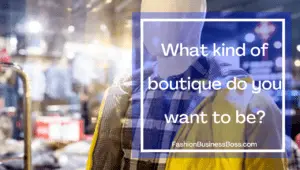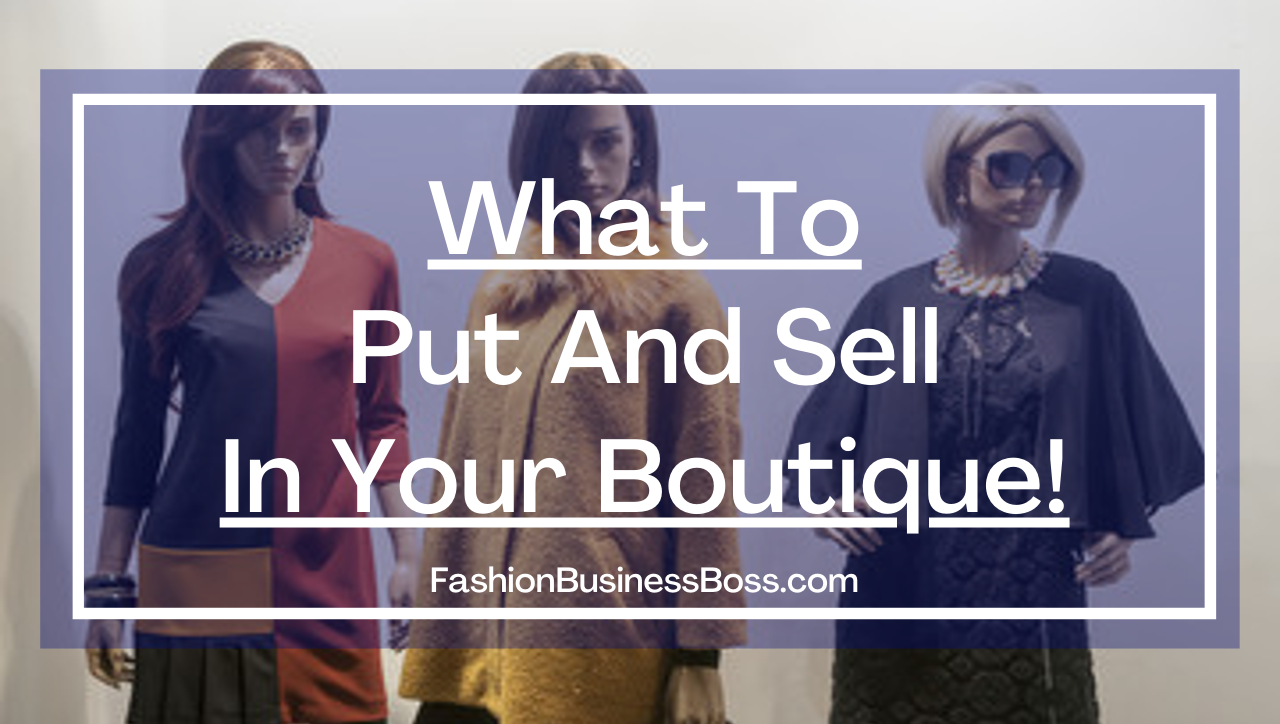Once you start your boutique, it’s time to sort out your inventory. But there are so many options—what do you decide to focus on? What kind of boutique do you want to be?
What to Put and Sell in Your Boutique:
- Women’s Clothing
- Men’s Clothing
- Undergarments
- Accessories
- Jewelry
- Other items like perfume, home décor, and makeup
So, what can you put and sell in your boutique? There are a few categories of clothing you can sell, with countless options in between. Read on to find out more about each category, how to price your items, and what kind of boutique you could be.
Women’s Clothing: This tends to be one of the most popular for boutique shopping, especially with luxury labels.

- T-shirts
- Jackets
- Any type of pant
- Sweaters
- Shirts
- Coats
- Sweatshirts and Hoodies
- Shoes
- Shorts
- Dresses
- Leggings
- Skirts
- Pajamas
- Swimsuits
- Suits
- sportswear
Men’s Clothing: not quite as popular as the women’s clothing option, you can still sell a number of different options in your boutique.
- T-shirts
- Jackets
- Any type of pant
- Sweaters
- Shirts
- Coats
- Sweatshirts and Hoodies
- Shoes
- Shorts
- Pajamas
- Swimsuits
- Suits
- sportswear
Undergarments: regardless of size, gender, or type, you can also sell any type of undergarment in your boutique.
- Panties
- Bras
- Boxer shorts
- Briefs
Accessories: while this encompasses a lot of what you’ll find in a boutique, you might find yourself needing to narrow it down to a few options.

- Handbags and purses
- backpacks
- Socks
- Sunglasses
- Scarves
- Handkerchiefs and bandanas
- Gloves
- Stockings and tights
- Hats and baseball caps
- hair accessories such as bands and pins
- belts
- ties
- wallets
Jewelry: no matter the quality, most boutiques will have some sort of jewelry options, even if it is a smaller kiosk in the larger store.
- Necklaces
- Bracelets
- Earrings
- Local and handmade items
- Watches
- Cufflinks
Other Items: this category is where some of the more “Knick knack” items lay.
- Perfumes
- Makeup
- Nail polish
- Cosmetic or travel bags
- Phone cases
- Umbrellas
- Smaller decorations for the home
What Are The Pros And Cons Of The Fashion Industry?
What kind of boutique do you want to be?
Now that you know what goes into a boutique and what you can sell, you can sort through exactly what you’d like your boutique to be. Finding that niche can also help sort out what items you want, so follow each step concurrently if you would like. Options for your boutique’s niche include:

- Selling your own brand. If you’re looking for a way to sell your own clothing line, this is a great way to start. Build your boutique around that brand, but make sure you branch out into a few different categories to gain more attention from your niche.
- Selling online. You can be a boutique shop without a physical storefront. Consider opening up your boutique online. You can focus all your efforts on making sure your social media and website are up to par, and market free online through those options. You also don’t have the overhead of a physical store, which means you don’t have to pay all that money—meaning it can go directly into your pocket or investing in your shop.
- Selling to a targeted niche. Finding that there aren’t enough sportswear shops in your community? What about plus sized options? If you want to go this route, it’s important that you do your market research beforehand. If you find that community is underserved and you have a way to combat that, consider a targeted niche for your boutique.
- Selling items of a particular culture or tradition. Are you in an area or can serve a community that is looking for traditional clothing? Consider focusing your boutique on that. There are plenty of cultural options that require and favor certain types of clothing, and you can sell directly to that community. Note that choosing a niche like this could alienate other possible customers, so it’s up to you to educate a larger community to what you’re doing and what you’re selling.
- Selling a particular type of clothing. This is a bit different than selling to a niche. While you are targeting an audience in that type of boutique, you are targeting an item in this type. You’ll see bridal shops, sportswear, or even jewelry boutiques function like this.
- Selling secondhand, resale, or consignment items. While this may not be your initial consideration of a “boutique” it has become more and more popular. People are looking to find sustainable fashion at a cheaper price, and you can capitalize on the “Thrill of the hunt” for those shoppers looking for vintage finds. This does mean you will have to work with customers trying to sell their items, so research and patience is necessary.
What Degress Do You Need To Own A Boutique?
What considerations should you make when pricing your boutique items?
No matter what you’re selling, you’re going to need to price them. How do you decide what price to put on your boutique clothing, and why do other boutiques seem to have high prices? There are a few factors that go into your price that you need to consider.

- Your labels. Are you purchasing for a successful, more expensive brand? Then you’ll have to price your items accordingly. Due to their popularity, demand is kept high and inventory is kept low, meaning you have the ability to charge more for that particular designer. That cost also includes time, energy, and how much the designer thinks their work is valued—and you have the opportunity to double that price, according to fashion industry profit margins.
- Your materials. Boutique brands tends to sell clothing that is higher quality, so that means your initial materials are going to cost more. If you’re developing your own fashion clothing line, you’ll have to factor this into your costs as well and pass it along to your customers in order to make a profit.
- Your manufacturing location. Where you have the clothing made or where the clothing is made that you purchase matters. Most luxury fashion houses will create their designs closer to home, which means higher costs than taking it to China or India for cheaper production. That also means keeping the inventory number low, which means demand will be high—another cost you will have to lay on your customers.
- Your marketing. How much marketing do you plan on completing? That cost comes directly from your profit, which means you have to determine how much you can spend marketing the product that pays for your marketing. It’s a cyclical part of your business, but that means whatever profit you make off your items has to account for your level of marketing and advertising. If you have a massive campaign, you will need to increase your profits.
- Your salaries. This is another factor that goes into your pricing, and it directly affects you. Are you looking to make six figures from your boutique? While that’s not likely to happen in your first few years, any sort of profit you’re trying to make comes from the cost of what you’re selling. If it’s not giving you enough profit, it’s impossible to make enough money to pay for you or your employees. Make sure your items are priced accordingly.
A boutique is a great way to get your fashion line out on the market, or it’s a great way to target a niche that you find underserved. Whether you’re struggling on deciding what to put in your business or how much to charge per item, go with your research and your passion. Make the best business decisions you can make through having the proper information and sticking to your plan.
What To Do If Your Clothing Line Fails And Five Ways To Prevent it!
RELATED QUESTIONS
How much experience do I need to start my own boutique?
It does not take any experience to start your own boutique. An education in business, fashion design, or art can help you in the long run, but they are not required. Start your business with a general knowledge of what owning a business could look like for you, and make sure you have the passion for the field.
Why are haute couture fashions so expensive?
Haute couture fashions are so expensive because of the quality of the work, the quality of the materials, the manufacturing costs, and the cost of the brand name. Because fashion design started as a way to create trends through the royal family of France in the 1700s, it has grown into the industry that it is today, with many fashion houses spanning over a century.
What is the difference between fast fashion and sustainable fashion?
Fast fashion is when a manufacturer or designer takes some sort of popular design, trend, or celebrity-inspired piece of clothing and creates it cheaply and fast in attempt to get it on the market as soon as possible. This kind of fashion quickly goes out of style, leaving items on deep discounts or even in landfills. On the other hand, sustainable fashion focuses on the environment and keeps clothing out of landfills, creating high-quality, long-lasting items that supersede trends and do not have to be discarded or put in landfills if they do not sell.
To learn more about how to start your own fashion clothing line check out my startup documents here
Please note: This blog post is for educational purposes only and does not constitute legal advice. Please consult a legal expert to address your specific needs.

Meet Shawn Chun: Entrepreneur and Fashion Business Fan.
I’m a happy individual who happens to be an entrepreneur. I have owned several types of businesses in my life from a coffee shop to an import and export business to an online review business plus a few more and now I create online resources for those interested in starting new ventures. It’s demanding work but I love it. I do it for those passionate about their business and their goals. That’s why when I meet a designer or boutique owner at a craft fair, farmers market, retail location or anywhere else I see myself. I know how hard the struggle is to retain clients, find good employees and keep the business growing all while trying to stay competitive.
That’s why I created Fashion Business Boss: I want to help fashion business owners like you build a thriving business that brings you endless joy and supports your ideal lifestyle.

